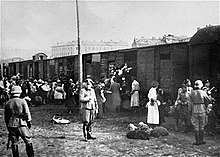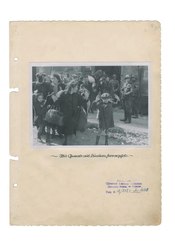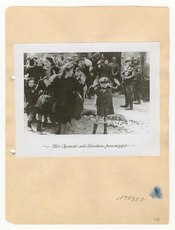Warsaw Ghetto boy

In the best-known photograph taken during the 1943
Background

In mid-1942, most of the Jews in the Warsaw Ghetto were
During the suppression of the uprising, Stroop sent daily communiqués to Higher SS and Police Leader Friedrich-Wilhelm Krüger in Kraków; Propaganda Company 689 and Franz Konrad took photographs to document the events.[9][10] Selected photographs and communiqués were compiled, along with a summary of German actions, as the Stroop Report, a personal souvenir for Heinrich Himmler.[11] The report was intended to promote Stroop's efficiency as a commander and excuse his failure to clear the ghetto quickly.[12] The report memorialized the supposed heroism of the SS men who participated in the suppression of the uprising, especially the sixteen who were killed by Jewish fighters.[3][13] More than 7,000 Jews were shot during the uprising, the vast majority noncombatants.[12]
The original title of the report was The Jewish Quarter of Warsaw is No More! (
Photograph
The photograph was taken during the Warsaw Ghetto uprising (between 19 April and 16 May)[16] in the Warsaw Ghetto. An Internet forum discussion on the "Marki Commuter Railway" Association for Defending the Remnant of Warsaw cautiously identified the location as Nowolipie 34 from similarities in the architectural details, especially the downspout. These claims are discussed in a 2018 Polish-language book, Teraz ′43 (Now ′43), by Magdalena Kicińska and Marcin Dziedzic.[14] The photographer was either Franz Konrad or a member of Propaganda Company 689.[9][10] Albert Cusian, Erhard Josef Knoblach and Arthur Grimm served as photographers in Propaganda Company 689; Cusian may have claimed to have taken the photograph.[10] On trial in Poland, Konrad claimed to have taken photographs during the uprising only so that he could complain about Stroop's brutality to Adolf Hitler. The court did not accept this claim. Convicted of personally murdering seven Jews and deporting a thousand others to death camps, Konrad was sentenced to death and executed in 1952.[3][17]
The photograph depicts a group of Jewish men, women and children who have been forced out of a bunker by armed German soldiers. The original caption was "Forcibly pulled out of bunkers" (German: Mit Gewalt aus Bunkern hervorgeholt).[14] Most of the Jews are wearing ragged clothing and have few personal possessions. After being removed from the bunker, they were marched to the Umschlagplatz for deportation to an extermination camp. In the center of the photograph is a small boy wearing a newsboy cap and knee-length socks who appears six or seven years old. He holds his hands up in surrender as SS-Rottenführer Josef Blösche holds a submachine gun pointing downwards in his direction.[14][16][5] The photograph contains many opposites; as Richard Raskin put it: "SS vs. Jews, perpetrators vs. victims, military vs. civilians, power vs. helplessness, threatening hands on weapons vs. empty hands raised in surrender, steel helmets vs bare-headedness or soft caps, smugness vs. fear, security vs. doom, men vs. women and children".[1] According to Frédéric Rousseau, Stroop probably chose to include the photograph in the report because it showed his ability to overcome Judeo-Christian morality and attack innocent women and children.[18]
Identification
The boy
There are several individuals who have been claimed to be the boy in the photo, but his identity remains unclear.
- Artur Dąb Siemiątek, born in Łowicz in 1935, was first proposed as the subject of the photo in 1950. Siemiątek was from a well-off family and his father was a member of the Judenrat in the Łowicz Ghetto, liquidated to Warsaw in 1941. Jadwiga Piesecka, a cousin of Siemiątek and resident of Warsaw, and her husband fled to the Soviet Union in September 1939. They survived the Holocaust and signed affidavits that Siemiątek was the boy in the photo in the 1970s.[10][14]
- In 1999, a 95-year-old man named Avrahim Zelinwarger told the Ghetto Fighters House in Israel that the boy in the photo was his son, Levi Zeilinwarger, born in 1932. Avrahim escaped to the Soviet Union in 1940, but his wife Chana (who would be the woman in the photograph), son, and daughter are all believed to have been killed during the Holocaust. Richard Raskin personally doubted the Zelinwarger claim because of the lack of resemblance between Levi and the boy in the photograph.[10][14]
- In 1978, Israel Rondel told the

- Tsvi Chaim Nussbaum (forensic anthropologist K. R. Burns of the University of Georgia revealed that Nussbaum had detached earlobes, unlike the boy in the photograph.[10]
Other individuals
The woman emerging from the building directly behind the boy was Gołda Stawarowska, according to Stawarowska's granddaughter Golda Shulkes. The boy with the white bag over his shoulder was identified as Ahron Leizer (Leo) Kartuziński (or Kartuzinsky)[24][25] from Gdańsk by his sister, Hana Ichengrin. The same person was also identified as Harry-Haim Nieschawer.[24] Polish-American Holocaust survivor Esther Grosband-Lamet said that the small girl on the extreme left foreground was her niece Channa (Hanka) Lamet[24][25] (or Hannah Lemet) (1937–1943) who was murdered at Majdanek. The woman wearing the scarf would then be Hanka's mother Matylda Goldfinger-Lamet[25] or Mathylda Lamet Goldfinger,[24] married to Mosze Lamet; the family was from Warsaw.[10][14][7]

The only identification that is certain is that of Rottenführer Josef Blösche, the SS man aiming the MP 28 submachine gun at the boy.[1][10][14] Blösche was born in the Sudetenland in 1912 and served in the Einsatzgruppen,[10] and he was a policeman employed at the Warsaw Ghetto during the uprising. Marek Edelman testified that Blösche murdered Jews as part of his "daily routine" and he was known to have committed violence against children and pregnant women.[1][14] Due to his performance during the suppression of the Warsaw Ghetto uprising, Blösche was awarded the War Merit Cross 2nd Class with Swords.[10] Blösche appears in several of the photographs in the Stroop Report. During his trial in East Germany, the photographs were used as circumstantial evidence for the prosecution. He was convicted of the murder of at least 2,000 people and executed in 1969.[14] Of the photograph, Blösche stated:
The picture shows me, as a member of the Gestapo office in the Warsaw Ghetto, together with a group of SS members, driving a large number of Jewish citizens out from a house. The group of Jewish citizens is comprised predominantly of children, women and old people, driven out of a house through a gateway, with their arms raised. The Jewish citizens were then led to the so-called Umschlagplatz, from which they were transported to the extermination camp Treblinka.[10]
During the trial, the Judge asked Blösche about the events depicted in the infamous photograph:
Judge: "You were with a submachine gun...against a small boy that you extracted from a building with his hands raised. How did those inhabitants react in those moments?"
Blösche: "They were in tremendous dread."
Judge: "This reflects well in that little boy. What did you think?"
Blösche: "We witnessed scenes like these daily. We could not even think."[26]
Legacy


The New York Times published the picture on 26 December 1945 along with others from the Stroop Report, which had been entered into evidence at the Nuremberg Trial. On 27 December it reprinted the photograph, stating:
The luckier of the ghetto's inhabitants died in battle, taking some Germans with them. But not all were lucky. There was a little boy, perhaps 10 years old. A woman, glancing back over her shoulder at the supermen with their readied rifles, may have been this boy’s mother. There was a little girl with a pale, sweet face. There was a bareheaded old man. They came out into the streets, the children with their little hands raised in imitation of their elders, for the supermen didn't mind killing children.[6]
The photograph was not well known until the 1970s,
The image has been used in some controversial artwork juxtaposing the Warsaw Ghetto uprising with the
The Holocaust survivor and artist Samuel Bak has created a series of more than a hundred paintings inspired by the photograph, as well as by his own experiences and the memory of a lost childhood friend. In these works, the boy's extended arms are often depicted with a crucifixion theme or with the boy seen as a part of an imagined monument.[28][29]
Both NARA and IPN describe the image as in the
Notes
- ^
- Haaretz: "One of the most compelling and enduring images of the Holocaust"[1]
- Time Magazine: "The Holocaust produced scores of searing images. But none had the evidentiary impact of the boy’s surrender."[2]
- Tablet Magazine: "The boy in question can be seen in one of the most famous images of the Holocaust"[3]
- Michael Rothberg: "the frequently reproduced photograph of a boy in the Warsaw Ghetto with his hands up—perhaps the most famous image from the Holocaust"[4]
- Jarosław Marek Rymkiewicz: "The photograph everyone knows: a boy in a peaked cap and knee-length socks, his hands raised"[5]
- Daniel H. Magilow and Lisa Silverman: "the image soon came to symbolize the entirety of the Holocaust".[6]
- ^
- Time Magazine: "The child, whose identity has never been confirmed, has come to represent the face of the 6 million defenseless Jews killed by the Nazis."[2]
- Haaretz: "A Picture Worth Six Million Names"[1]
- Hidabroot: "His anonymity symbolizes the one and a half million children who perished in the Holocaust and were reduced to ashes."[7]
References
- ^ a b c d e f g Maltz, Judy (3 March 2011). "Holocaust Studies / A picture worth six million names". Haaretz. Retrieved 23 September 2018.
- ^ Time Magazine. No. 100 Photographs | The Most Influential Images of All Time. 17 November 2016. Archived from the originalon 12 November 2020. Retrieved 23 September 2018.
- ^ Tablet Magazine. Retrieved 23 September 2018.
- ^ S2CID 144587788.
- ^ S2CID 144711178.
- ^ ISBN 978-1-350-09182-5.
- ^ a b c Stein, Shira (24 August 2014). "Who is that Boy in the Famous Warsaw Ghetto Picture?". Hidabroot. Archived from the original on 24 September 2018. Retrieved 24 September 2018.
- ^ ISBN 978-0-253-00202-0.
- ^ a b Tomasz Stempowski (17 March 2013). "Zdjęcia z powstania w getcie" [Photos of the ghetto uprising] (in Polish). Retrieved 8 October 2013.
- ^ a b c d e f g h i j k l m n Raskin, Richard (2007). "The Boy in the Photo?". Retrieved 23 September 2018.
- ^ a b c "Stroop Report (full high resolution copy)". Tiergartenstrasse 4 Association. Archived from the original on 30 March 2015. Retrieved 23 September 2018.
- ^ a b c d "Stroop's Report in the new version". Jewish Historical Institute. Archived from the original on 24 September 2018. Retrieved 23 September 2018.
- ^ a b c Jeannelle, Jean-Louis.""L'Enfant juif de Varsovie. Histoire d'une photographie", de Frédéric Rousseau" [The Jewish child of Warsaw. The story of a photograph by Frédéric Rousseau]. Le Monde (in French). 8 January 2009. Retrieved 24 September 2018.
- ^ a b c d e f g h i j k Nowik, Mariusz (19 May 2018). "Only the oppressor has a name. The story of the boy from the picture". TVN24. Retrieved 23 September 2018.
- ^ ISBN 978-1-86064-546-4.
- ^ a b c d e Sumpf, Alexandre. "L'enfant juif de Varsovie" [The Jewish child of Warsaw] (in French). 2 October 2013. Retrieved 24 September 2018.
- ^ a b c "Boy An Icon For Childhoods Lost In Holocaust". NPR. Retrieved 24 September 2018.
- ^ Kowalski, Waldemar. "To zdjęcie z getta mówi więcej niż tysiąc słów. Wypędzani Żydzi, eskorta Niemców i przerażony wzrok małego chłopca..." [This picture from the ghetto says more than a thousand words. Expelled Jews, an escort of Germans, and the terrified eyes of a small boy...]. NaTemat.pl (in Polish). 19 April 2016. Retrieved 24 September 2018.
- ^ a b c d Margolick, David (28 May 1982). "Rockland Physician Thinks he is the Boy in Holocaust Photo Taken in Warsaw". The New York Times. Retrieved 23 September 2018.
- ^ a b c Berger, Joseph (12 October 2012). "The Ghetto, the Nazis and One Small Boy". The New York Times. Retrieved 23 September 2018.
- ^ Harris, Clay (17 September 1978). "Warsaw Ghetto Boy-Symbol of The Holocaust". The Washington Post. Retrieved 9 May 2020.
- ^ "Dr. Tsvi Chaim Nussbaum". The Journal News. Archived from the original on 24 September 2018. Retrieved 23 September 2018.
- ^ Kleikamp, Antonia (29 April 2018). "Warschau 1943: Wer ist der Junge auf dem berüchtigten Getto-Foto?" [Warsaw 1943: Who is the boy in the infamous ghetto photograph?]. Die Welt (in German). Retrieved 24 September 2018.
- ^ a b c d "German soldiers pointing guns at women and children during the liquidation of the ghetto. The original German caption (Stroop collection) reads: "Pulled from the bunkers by force" Warsaw, Poland, April 19 – May 16, 1943". Yad Vashem. Archived from the original on 3 February 2022. Retrieved 11 October 2018.
- ^ a b c "Jews captured by SS and SD troops during the suppression of the Warsaw ghetto uprising are forced to leave their shelter and march to the Umschlagplatz for deportation". United States Holocaust Memorial Museum. Retrieved 11 October 2018. (Photograph Number: 26543)
- ^ Porat, Dan (2013). The Boy: A Holocaust Story (in Hebrew). Dvir.
- ISBN 9780813225890.
- ^ "Holocaust Survivor/Artist Asks Tough Questions". Wabash College. Retrieved 25 September 2018.
- OCLC 318057887.
- TIME. Retrieved 8 November 2018.
- ^ "Nazis Arresting Jews in Warsaw Ghetto". Getty Images. Retrieved 1 November 2018.
Further reading
- ]
- ISBN 978-0-8090-3072-9.
- Raskin, Richard (2004). A Child at Gunpoint: A Case Study in the Life of a Photo. ISBN 9788779340992.
- ISBN 9782021212334.




